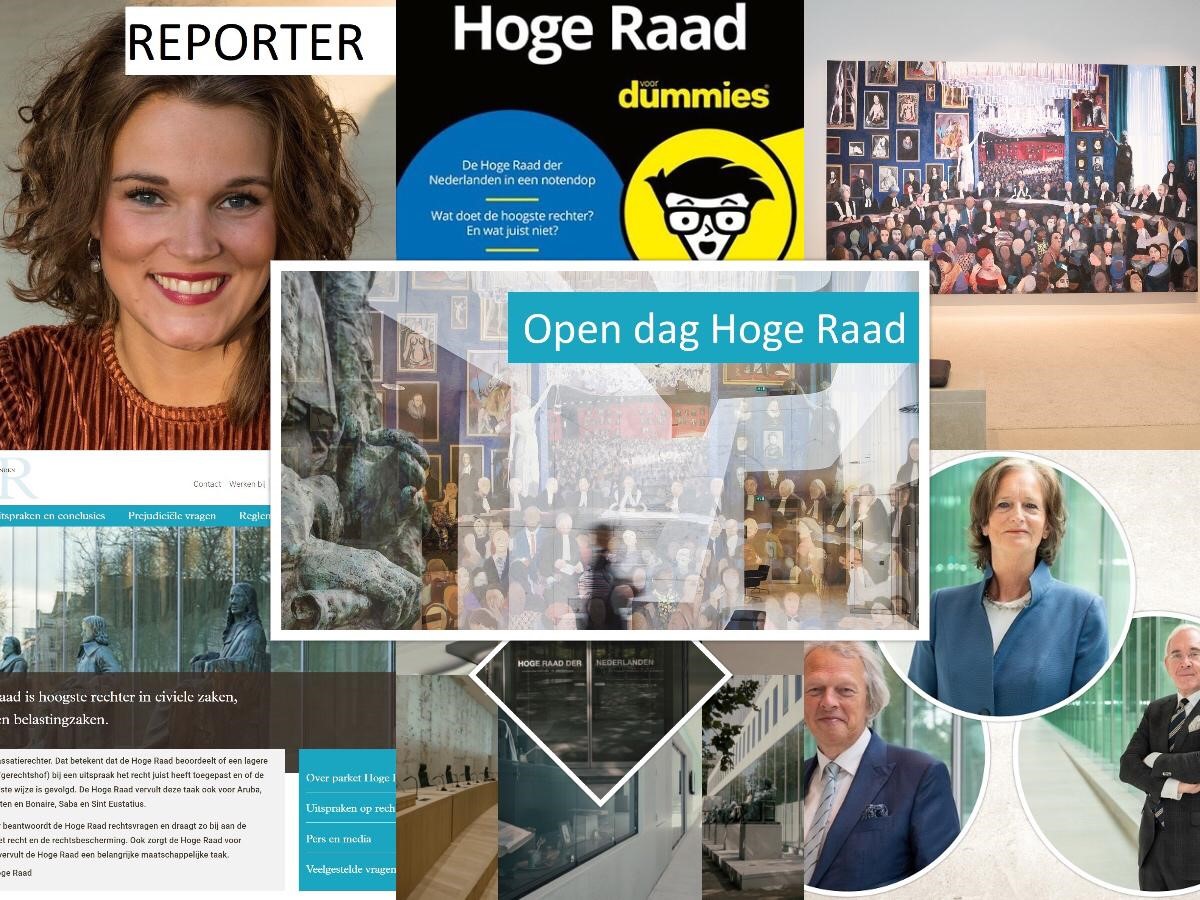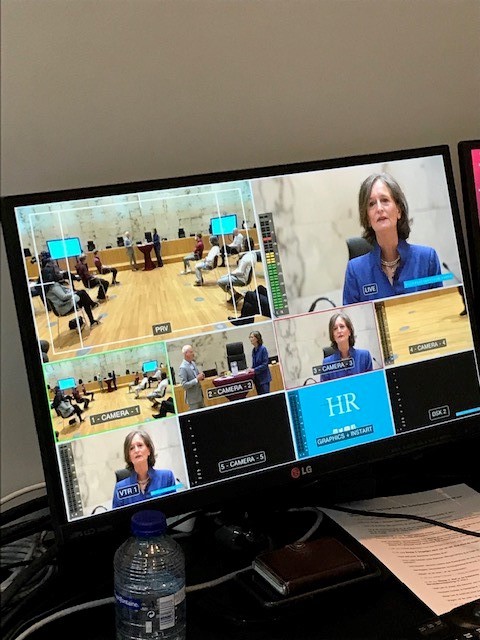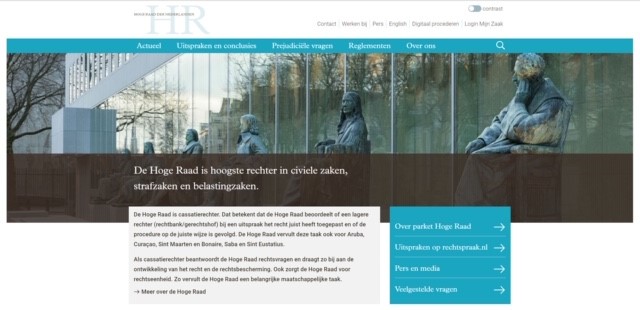Contact with the public
The Supreme Court plays a vital role in society in light of its three key tasks (development of the law, uniformity of the law, and legal protection). Access to cassation proceedings before the highest court must be guaranteed. It is also essential for the course followed by the country’s senior justices – and the institution that determines that course – to be identifiable. In this sense, the highest court is a beacon for legal practice and society, and must therefore be easily visible and point in a clear direction.
Every year the Supreme Court undertakes a range of activities highlighting the Court’s importance for society. Some aim to make the Court more visible and identifiable, and provide opportunities to get to know more about its role. In other activities members and staff of the Supreme Court make themselves available to answer general questions or provide information about that role. These activities continued in 2020, ‘the year of coronavirus’.
Publication of judgments, advisory opinions and news items; use of Twitter and production of live streams
As in previous years, in 2020 the Supreme Court and the Procurator General’s Office published a considerable number of judgments and advisory opinions, in some cases accompanied by a news item and/or a tweet. In 2020 the Court live-streamed the pronouncement of a number of judgments: in the criminal law field this included judgments in the case concerning euthanasia for people with advanced dementia, the case against the person charged with the rape and manslaughter of Anne Faber, the case concerning the murder of businessman Koen Everink and the case against the person prosecuted for the rape and manslaughter of Nicole van den Hurk. The Civil Division live-streamed a case concerning the return of several ISIS travellers and their children, as well as the oral pleadings in a case with a large number of parties who could not be accommodated in the courtroom. In addition, a number of judgments and news items were translated into English in view of international interest in these cases.
Open Day
The annual Open Day took place on Saturday 12 September 2020. The aim of this day is to give people the opportunity to observe the administration of justice from close quarters. Because of the coronavirus restrictions, the Open Day took place largely online in a live-stream that was open to all. A small number of people could be physically present in the building for part of the programme. Members of the public were able at different points in the day to have a moderated conversation with two justices and an advocate general, where they asked questions such as ‘what does your work entail?’, ‘how do you become a Supreme Court justice or an advocate general?’, ‘what are some of your most important cases?’ and ‘what is a hearing in judges’ chambers?’.


At a ‘normal’ open day a member of staff stands next to Helen Verhoeven’s painting of the Supreme Court, which is on display in the reception area, and explains the different things to be seen in the work. In 2020 this was done online. Visitors to the website could click on the painting and move the mouse over the work to open text boxes with information about interesting aspects. This is now a permanent feature of the Court’s website. [link].
The website offers a virtual tour of the building, supplemented on the Open Day with three specially made guided tour videos that showcase the six statues in front of the building, Grotius’ words UBI IUDICIA DEFICIUNT INCIPIT BELLUM (where the courts fall short, war begins) on the wall behind the statues, and the great courtroom. These videos now also have a permanent place on the website.
New website
The new Supreme Court website went live on the Open Day. Until then, the Court had maintained three separate websites. The general website was a subsite of www.rechtspraak.nl and the website www.hogeraad.nl merely offered access to the online portals. There was also a third site for the Court’s annual reports. This was undesirable in a number of ways: it was not clear to potential visitors what information each site offered and none of the sites provided all the information available. The Supreme Court therefore decided to redesign and expand www.hogeraad.nl. The new website integrates information for the public about the Court and the Procurator General’s Office with the online portals. The site is more user-friendly, has a modern look and feel, and is easy to find and search. It is also easy to view on a tablet or smartphone.

Straightforward Communication
Clear and comprehensible use of language is essential in improving both access to the judicial system and contact with the public. The courts must write in plain language, so that their judgments are clear. This also applies to the highest court. In 2018 the Supreme Court launched the Straightforward Communication project, aimed at producing clear, comprehensible and readable judgments in which considerations and decisions are presented transparently and effectively. The project continued in 2019 and 2020 with a series of workshops for justices and advocates general, research assistants and the secretariat. A workshop on writing comprehensible legal texts was included in the introduction programme for new Research Service staff.
Students and schoolchildren
In collaboration with the Supreme Court, the ProDemos Centre for Democracy and the Rule of Law provides a range of educational programmes. For example, symposia are regularly held in the Court building and the Court has contacts with universities, institutions of higher professional education and secondary schools, bringing large numbers of students and schoolchildren to the building. These activities were limited in 2020 due to the coronavirus restrictions. Nevertheless, in February 2020 the Court was involved in the annual event for social studies teachers. The Court had a stall at the information fair in the Grote Kerk where visitors could talk to one of the justices, while a number of teachers were welcomed to the Court building.
Publication of pre-2000 judgments
In 2020 the Supreme Court took further steps to arrange for the online publication of a large number of important judgments dating from before 2000. Since that year, Supreme Court rulings have been anonymised and published on rechtspraak.nl. Before 2000 they were published almost exclusively in non-digital, edited collections of law reports. Publishers made some judgments available in electronic form, usually edited, in databases which could only be accessed with a subscription. The Supreme Court believes it has a public duty to make some of these important older rulings available online and free of charge. In 2018 it took the first step by creating a list of over 500 judgments and inviting other parties to add to it. In December 2019 the Court published the first 150 rulings, including the relevant advisory opinions of the advocates general. In 2020 it continued to work on digitalising the most important pre-2000 judgments. In May 2020, 75 rulings were published, including the Felix/Aruba, Holland Nautic/Decca and De Bourbon Naundorff judgments in civil proceedings and the Unilever and Ex-warrant loan judgments in tax cases. In September 2020 another 100 rulings followed, including Dentists (1958), Osby (1981), Crossing deer (1983) and DES daughters (1992), all civil proceedings. In addition the following judgments in criminal cases were published: The poisoned cake (1911), The Azewijn horse (1915) Electricity (1921) and Oude Kijk in ’t Jatstraat (1932), and one judgment in a tax case (Vehicle costs (1979)). In December 2020 another 75 rulings were added, including the following civil judgments: Frascati Ensemble (1914), Quint/Te Poel (1959), Harmonisation Act (1989), Van Geest/Nederlof (1990/1991) and Wrongful birth (1997); the following criminal judgments: Aflatoxin in peanuts (1993), Zwolsman (1995) and Pikmeer I (1996) and three tax judgments: Fine is ‘criminal charge’ under article 6 ECHR (1990), Fine following settlement penalty for same offence (1990) and Receiver bears liability for Inspector (1990). A total of 400 pre-2000 judgments have now been published in electronic form. In 2021 the Supreme Court will continue with this work.
The Supreme Court and social media
The Supreme Court has used Twitter for business communications and as a useful tool in media relations for some time now. It has over 30,000 followers on Twitter. The Court is also present on other social media channels, including a business account on LinkedIn, Facebook and Instagram (over 1,300 followers). A social media presence offers a variety of opportunities, enabling the Court to differentiate its messages and target groups, offer up-to-date news and share the Supreme Court’s story.